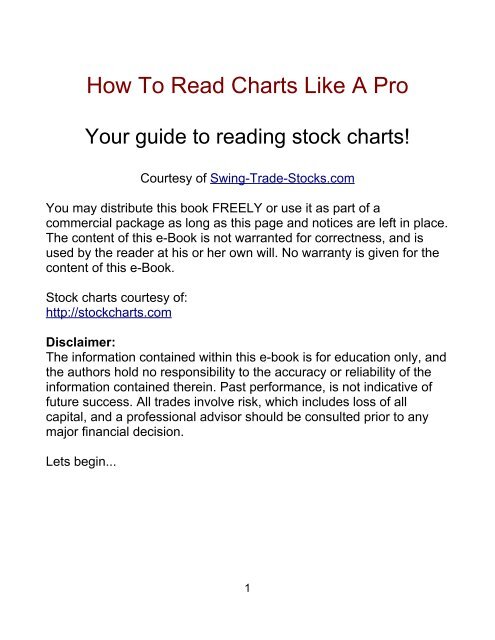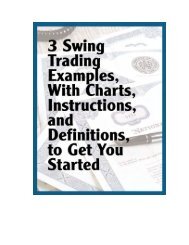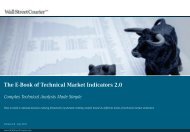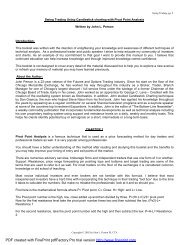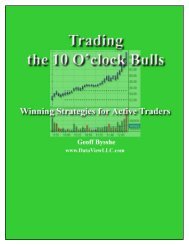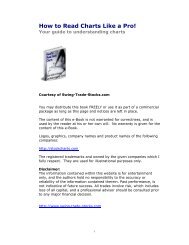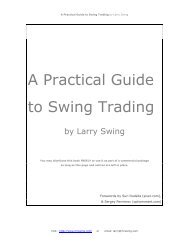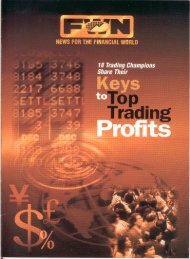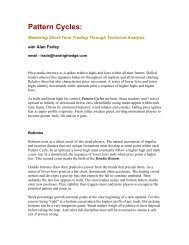How To Read Charts Like A Pro - The Swing Trading Guide
How To Read Charts Like A Pro - The Swing Trading Guide
How To Read Charts Like A Pro - The Swing Trading Guide
You also want an ePaper? Increase the reach of your titles
YUMPU automatically turns print PDFs into web optimized ePapers that Google loves.
<strong>How</strong> <strong>To</strong> <strong>Read</strong> <strong>Charts</strong> <strong>Like</strong> A <strong>Pro</strong><br />
Your guide to reading stock charts!<br />
Courtesy of <strong>Swing</strong>-Trade-Stocks.com<br />
You may distribute this book FREELY or use it as part of a<br />
commercial package as long as this page and notices are left in place.<br />
<strong>The</strong> content of this e-Book is not warranted for correctness, and is<br />
used by the reader at his or her own will. No warranty is given for the<br />
content of this e-Book.<br />
Stock charts courtesy of:<br />
http://stockcharts.com<br />
Disclaimer:<br />
<strong>The</strong> information contained within this e-book is for education only, and<br />
the authors hold no responsibility to the accuracy or reliability of the<br />
information contained therein. Past performance, is not indicative of<br />
future success. All trades involve risk, which includes loss of all<br />
capital, and a professional advisor should be consulted prior to any<br />
major financial decision.<br />
Lets begin...<br />
1
Table Of Contents<br />
Inside...<br />
Introduction<br />
Stages, Trends, and Waves<br />
Chart Analysis<br />
Resources<br />
Tips<br />
2
<strong>How</strong> to <strong>Read</strong> Stock <strong>Charts</strong><br />
Introduction<br />
Make no mistake about it. <strong>Read</strong>ing charts is an art form that can be<br />
mastered! <strong>The</strong>re are many factors on a chart that go into making trade<br />
decisions.<br />
You have to be able to analyze all of these factors and come to a<br />
conclusion about whether or not to risk your hard earned money on a<br />
trade. This is what separates the novice trader from the professional.<br />
<strong>The</strong>re are several things on a chart that make it worthy of trading. <strong>The</strong><br />
questions that you want to ask yourself about the chart are:<br />
●<br />
What stage is this stock in<br />
●<br />
Is this stock in and uptrend or a downtrend<br />
●<br />
Is the stock at the beginning, middle, or end of the trend<br />
●<br />
<strong>How</strong> strong is the trend<br />
●<br />
Where are the trend lines<br />
●<br />
What wave is this stock in<br />
●<br />
What do the moving averages tell me<br />
●<br />
Was there a breakout recently<br />
●<br />
Is the chart "smooth" or "sloppy"<br />
●<br />
Are there any chart patterns<br />
3
●<br />
Are there wide range candles in the direction of the trend<br />
●<br />
●<br />
Are there any gaps in the direction of the trend<br />
Are professionals selling strength or buying weakness<br />
●<br />
Where are the support and resistance areas<br />
●<br />
Is this stock at a Fibonacci level<br />
●<br />
What does volume tell me<br />
I know it seems like a lot of information to try and keep track of but all<br />
of the above questions are essential to chart reading mastery! Now,<br />
print out that page of questions and keep it handy next to your<br />
computer. Make several copies so that you can check off and make<br />
notes as you analyze your next chart. Go ahead, I'll wait…<br />
Got it printed out Great! Now you won't forget anything important<br />
when it's time to analyze a chart for your next trade. In the heat of<br />
battle, when emotions are running high, it is very easy to forget to look<br />
for some of the most basic things on a chart. I've done it. That is, until<br />
I made this list!<br />
Ok, now let's go through the list one by one to make sure that you<br />
know how to answer the questions correctly. Don't worry, with<br />
practice, you will not even need to think about these things. It will<br />
become automatic.<br />
You will be able to read charts with lightning fast speed. In just a<br />
couple of seconds you will be able to glance at a chart and know all<br />
the answers to the questions above.<br />
4
Stages, Trends, and Waves<br />
Direction<br />
Ok, let's looks at an example chart…<br />
Nice chart! This stock broke out through a consolidation in July and<br />
now it is in a nice strong trend. <strong>The</strong> green arrow is the day on which<br />
we see this stock. So, what questions can we answer just from<br />
glancing at this chart<br />
This stock is in stage two.<br />
You remember the stages right Stage one is a consolidation, stage<br />
two is an uptrend, stage three is another consolidation, and stage four<br />
is a downtrend. This stock was in a stage one in July but at the end of<br />
July, it broke out into a stage two. It is currently still in a stage two.<br />
This stock is in an uptrend.<br />
This is the easy part. If a stock is heading toward the upper right<br />
corner of a chart then it is in an uptrend! For some reason, this tends<br />
5
to elude some traders.<br />
This stock is near the middle or end of the trend.<br />
<strong>How</strong> do we know that <strong>The</strong> breakout signals the start of the trend.<br />
<strong>The</strong>re has already been one significant pullback. Had we bought stock<br />
on the first pullback, then we would have concluded that we are at the<br />
beginning of the trend. But since this is the second pullback, then we<br />
know that this trend may not last much longer.<br />
This stock is in a strong trend.<br />
<strong>The</strong> ADX indicator (not shown) is near 30 which we consider to be a<br />
fairly strong trend. <strong>The</strong> higher the ADX, the stronger the trend. This<br />
stock is at the lower trend line. You can see by the thick green line<br />
that this stock has hit the lower trend line. You can draw the trend<br />
lines in manually, but after you have been trading for awhile, you will<br />
not need to draw them. You will be able to see them automatically.<br />
This stock is in the fourth wave.<br />
In Elliott Wave theory, a stock goes through 5 waves in an uptrend. In<br />
the chart above, the first wave after the breakout is wave 1. <strong>The</strong> first<br />
pullback is wave two, the next wave up to $69.00 is wave three, and<br />
the pullback that we are in now is wave four. <strong>The</strong>re is one more wave<br />
to go!<br />
Conclusion<br />
Now we have identified that the possible future direction of this stock<br />
is up. Nothing is ever certain in the stock market! <strong>How</strong>ever, by looking<br />
at this chart we can be certain that the probabilities are on our side for<br />
a continued move to the upside.<br />
After you finish reading this book, go through some charts and try to<br />
identify the various factors mentioned above. Just understanding the<br />
nature of stocks and the different stages, trends and waves that all<br />
stocks go through will greatly improve you trading. Soon, all of this<br />
direction analysis will become second nature. You won't even have to<br />
6
think about it.<br />
Were not done yet! Go on to the next chapter…<br />
7
Chart Analysis<br />
Price<br />
Price, as interpreted by candles, is the most important factor to<br />
consider on a chart. Put away the technical indicators. You do not<br />
need them. Technical indicators serve one purpose – to confuse<br />
novice traders! <strong>The</strong>re isn't anything on a chart that can be learned<br />
from them. Everything you need to know is right in front of you in the<br />
candles!<br />
Ok, let's go back to our chart example:<br />
<strong>The</strong>re are some very significant things happening on this chart. Do<br />
you see them You will in a minute.<br />
We continue answering questions…<br />
<strong>The</strong> moving averages are lined up.<br />
We want the 10 SMA above the 30 EMA and we also want there to be<br />
plenty of space in between the two moving averages. This creates the<br />
8
Traders Action Zone (TAZ) that we can trade in. If the moving<br />
averages move too close together, then a trading range or basing<br />
pattern will likely develop. We don't want that!<br />
<strong>The</strong>re was a breakout recently.<br />
This is good! We want to buy a pullback as close as possible to a<br />
breakout as we can. Why We want to know that there is interest in a<br />
stock. Remember that institutional traders have to accumulate shares<br />
over time. <strong>The</strong>y can't buy tons of shares all at once. <strong>The</strong>y have to<br />
buy a little at a time. By looking for breakouts, we can expect them to<br />
have to buy more in the future. This will propel the stock higher.<br />
This is a smooth chart.<br />
We don't want to trade stocks that are whipping around everywhere!<br />
That is a good way to get stopped out on trades. This stock is in a<br />
smooth uptrend that can be traded with confidence, and without fear<br />
of getting shaken out of the trade.<br />
No significant chart patterns.<br />
In this example, there aren't any significant chart patterns. This is<br />
fine. You don't need any kind of a chart pattern like a cup and handle<br />
pattern, or a triangle to trade a stock. You do, however, want to be<br />
able to identify them when they are there. This could add some<br />
weight to the setup and may make us favor one trade over another.<br />
<strong>The</strong>re are wide range candles in the direction of the trend.<br />
See how at the end of August there are three wide range candles that<br />
close near the top of their range <strong>The</strong>re was also a wide range candle<br />
on the breakout in July. This is very significant! In fact it may be one<br />
of the most significant things on the chart. Stocks tend to move in the<br />
direction of wide range candles.<br />
<strong>The</strong>re is one significant gap.<br />
<strong>The</strong>re is only one significant gap to the upside on the breakout in July.<br />
Ideally, we would like to see more. A better case scenario would be if<br />
9
there was a more recent gap. Why Because stocks tend to move in<br />
the direction of gaps! Be careful though. After three or more gaps, a<br />
stock can become overbought and may not continue to move forward.<br />
<strong>Pro</strong>fessionals are buying weakness.<br />
<strong>How</strong> do we know this We know by looking for "tails" or "shadows" at<br />
the bottom of the candles. On the sixth of September there is a tail,<br />
and on this day (green arrow) there is a tail. This is very significant!<br />
You want to see that the big players are coming in to support the<br />
stock. You want them to protect you from any downside risk.<br />
This stock is at support.<br />
This stock has pulled back to a prior high made in the middle of<br />
August. This is identified by the red/green support line drawn on the<br />
chart. When a stock pulls back to a prior high it is known as minor<br />
support. It is still a significant support area, just not as significant as<br />
if it pulled back to a prior low.<br />
For example, if the stock pulled back to<br />
the prior low at $63.00 (see chart), then it would be major support.<br />
Also, notice how the lower trend line and the support line converge<br />
into one right at today's candle (green arrow). This is very significant!<br />
This increases the strength of the support.<br />
This stock is at a Fibonacci retracement level.<br />
<strong>The</strong>re are three Fibonacci retracement levels that you look at: 38.2%,<br />
50%, and 61.8%. This stock has pulled back to the 38.2% level (not<br />
shown on the chart above). You want to trade pullbacks to this level<br />
or the 50% level. If it goes down to the 61.8% level, it may be<br />
signaling weakness. Avoid those stocks. Note that this level also<br />
corresponds with the support line.<br />
Volume is showing that there is interest in the stock.<br />
See the big volume on up days and the lower volume on down days<br />
This is the ideal scenario but it isn't absolutely necessary. I tend to<br />
10
favor low volume pullbacks over high volume pullbacks but I will trade<br />
both. If a stock is pulling back on low volume, it means that traders<br />
have lost interest in the stock and things get really quiet. This is<br />
usually when institutional traders come in – when everyone forgets<br />
about the stock!<br />
Conclusion<br />
This concludes our analysis of the stock. We have determined that we<br />
are going to trade this stock!<br />
Want to see what happens next<br />
Nice! All of our analysis has paid off. This stock has successfully<br />
moved in our favor and now we can just trail our stops under the lows<br />
of the candles until stopped out.<br />
I know it seems like a lot of work went into analyzing this chart but<br />
what can I say – trading stocks does take some work! It will,<br />
11
however, get faster with time. After you look at thousands and<br />
thousands of charts in this manner, everything will become second<br />
nature. Instead of it taking minutes to look at a chart it will take<br />
seconds.<br />
I hope you have enjoyed reading this little e-book. More importantly,<br />
I hope that you can use this information and profit from it! After all,<br />
that is the goal – to make consistent profits in the stock market.<br />
In the next section, you will find various resources around the net to<br />
help you with your trading and then some trading tips...<br />
12
Resources<br />
Around the net<br />
Here are some other trading websites and resources that you can use<br />
to jump start your trading.<br />
Traders Bookstore – This is my bookstore in association with Traders<br />
Library.<br />
Investopedia – This website has an enormous collection of articles<br />
related to trading stocks.<br />
Chart Patterns – This website has descriptions of chart patterns and<br />
how to trade them.<br />
Chart School – This section on Stockcharts.com is a good resource<br />
for learning technical analysis.<br />
InvestorWords – Here you can look up words that you are not familiar<br />
with and get the definition.<br />
Elliott Wave – This website offers a free tutorial in Elliott Wave theory.<br />
InvestorFlix – For less than $20 bucks a month, you can get stock<br />
market dvd's delivered to your house. Excellent learning tool.<br />
Trade Tracker – This is the portfolio tracker I use to manage my<br />
trades. It's inexpensive and easy to use.<br />
<strong>The</strong> Definitive <strong>Guide</strong> to <strong>Swing</strong> <strong>Trading</strong> – <strong>The</strong>re are a lot of e-books out<br />
there on trading stocks. This is one that I can recommend.<br />
13
<strong>Trading</strong> Tips<br />
In Conclusion...<br />
●<br />
Remember that there is always another trader on the other side<br />
of the trade doing the exact opposite that you are doing. Only<br />
one of you can be right.<br />
●<br />
Waiting around for the perfect trade or the perfect opportunity will<br />
guarantee that you never trade stocks.<br />
●<br />
<strong>Trading</strong> stocks is about probabilities, NEVER certainties. You are<br />
not smart enough to predict, with consistency, what will come<br />
next.<br />
●<br />
Conventional wisdom is usually wrong. Trade against the crowd,<br />
not with them.<br />
●<br />
Money, trade, and self management has always been and will<br />
always be the holy grail to trading stocks.<br />
Well, that's about it for now. This little tutorial will help you learn to<br />
read charts but there is still so much more to learn!<br />
Got questions<br />
Send me an email using the contact form on the website.<br />
Best wishes and much success!<br />
14


